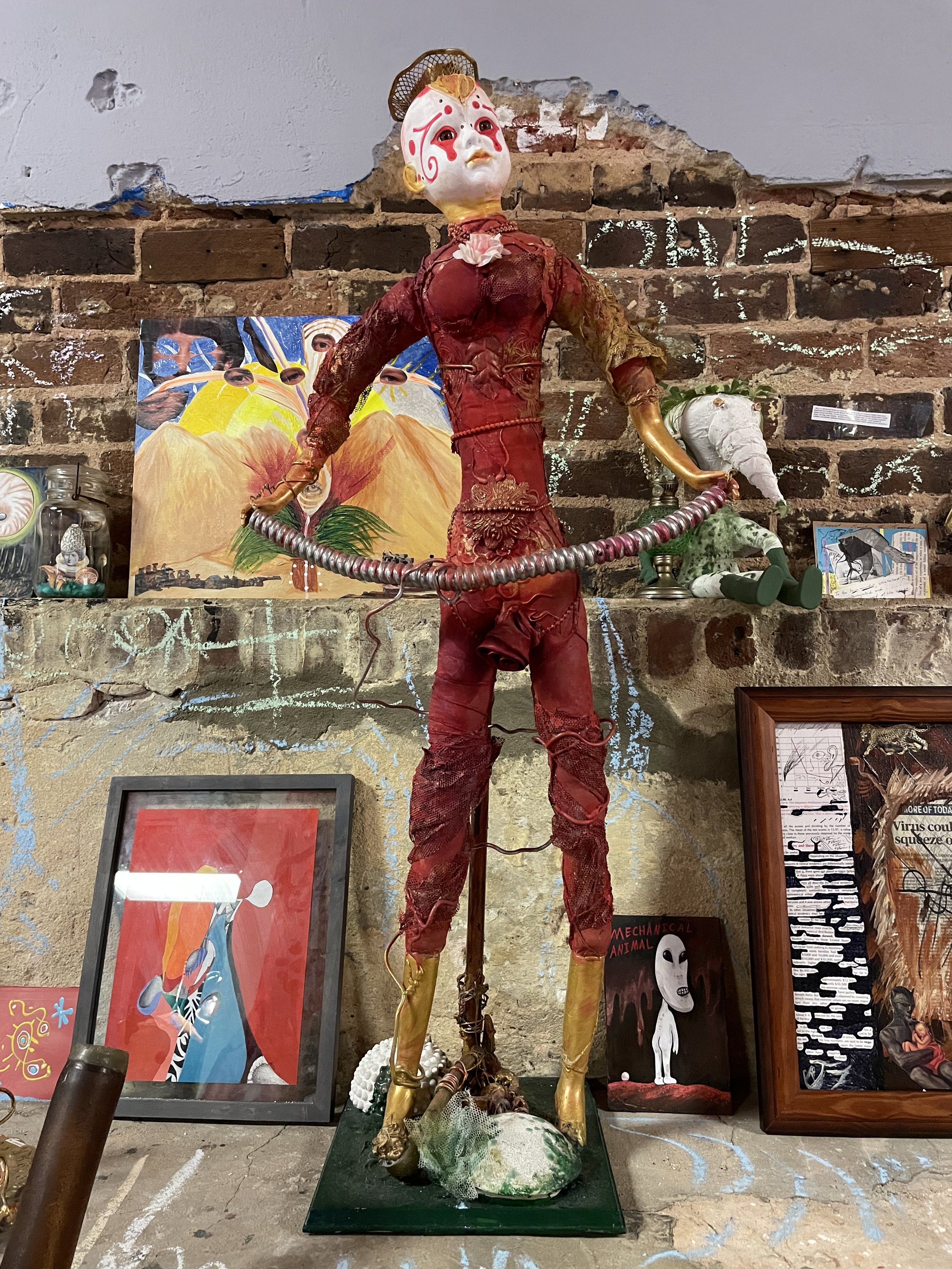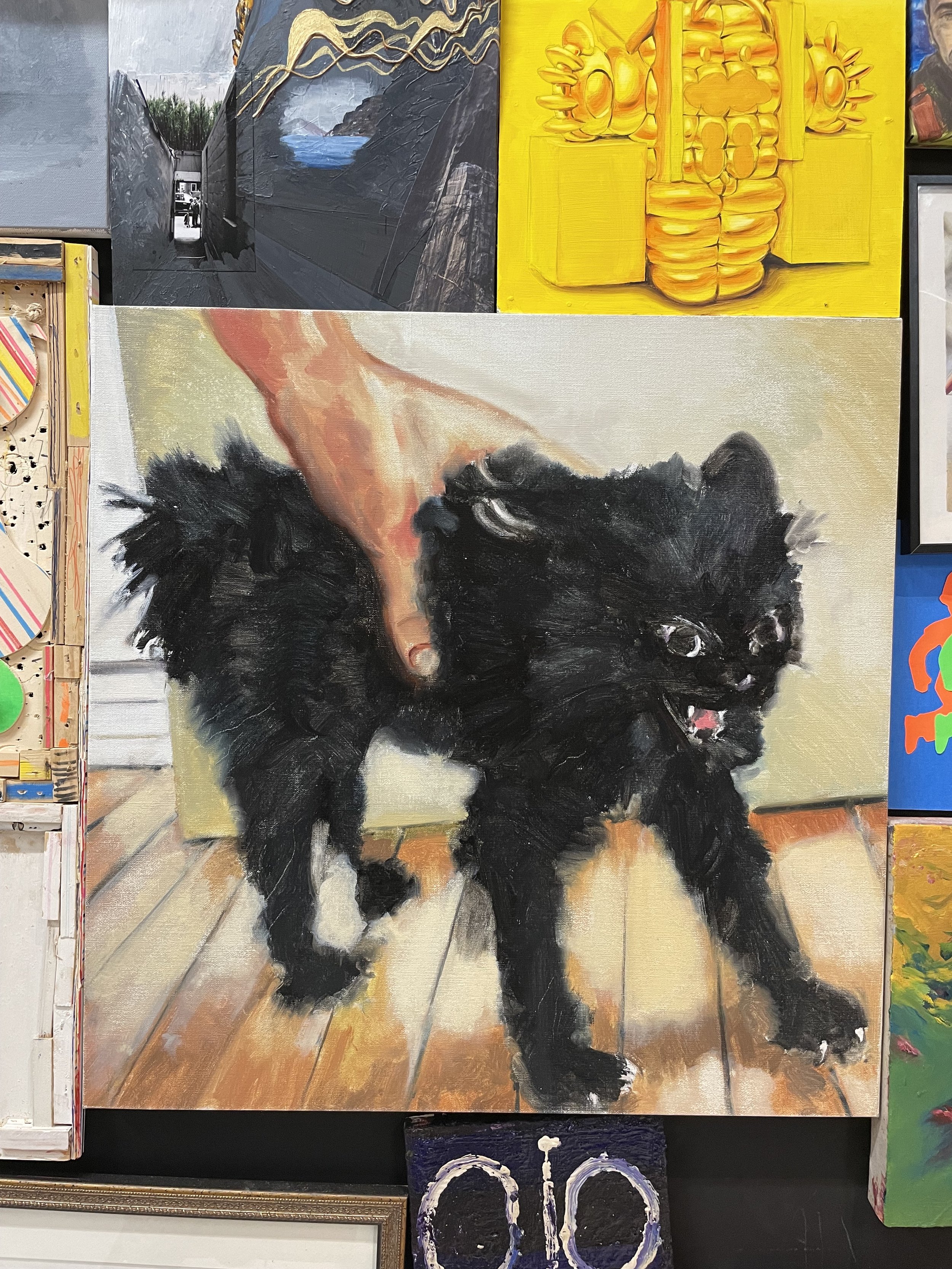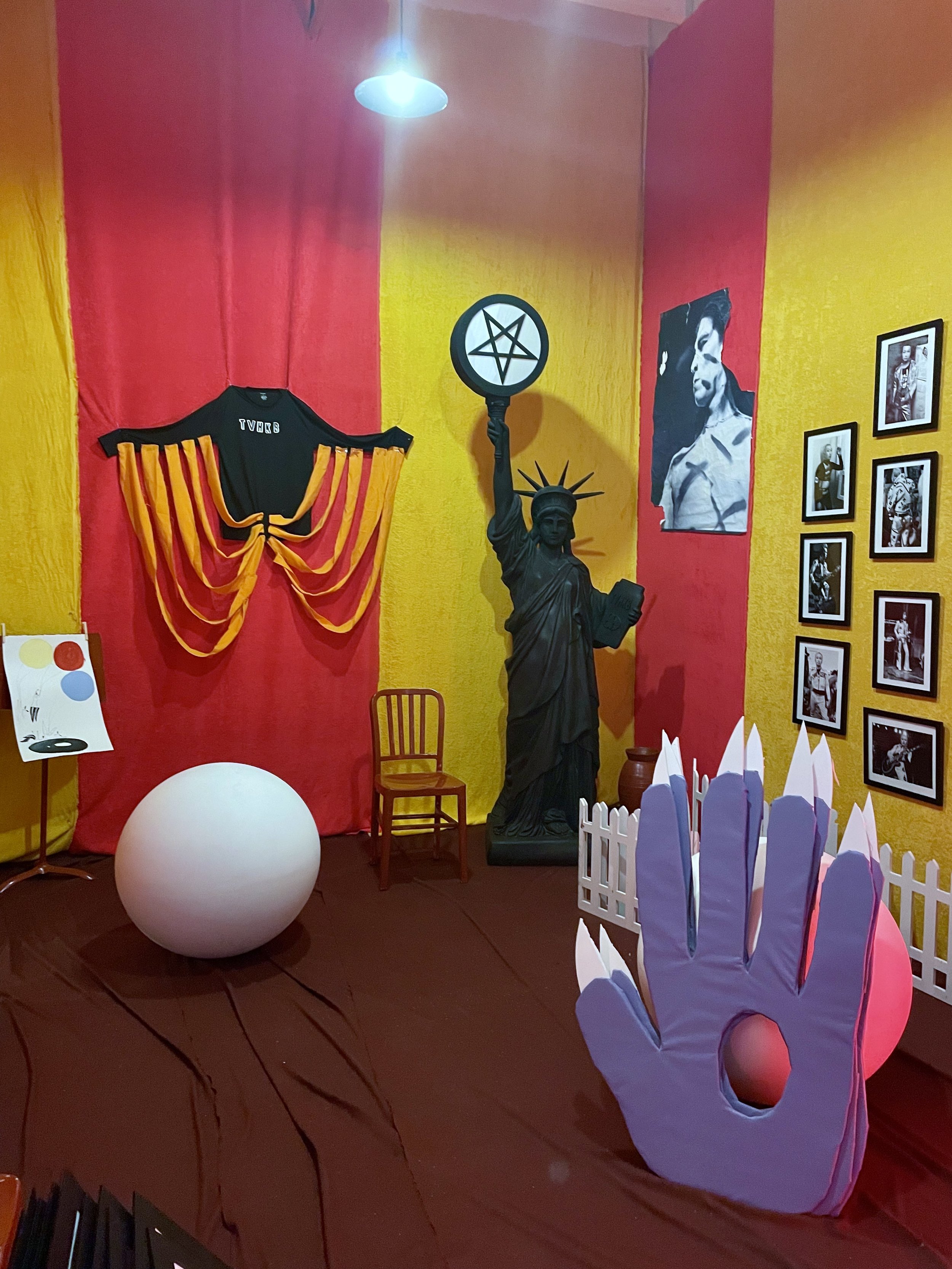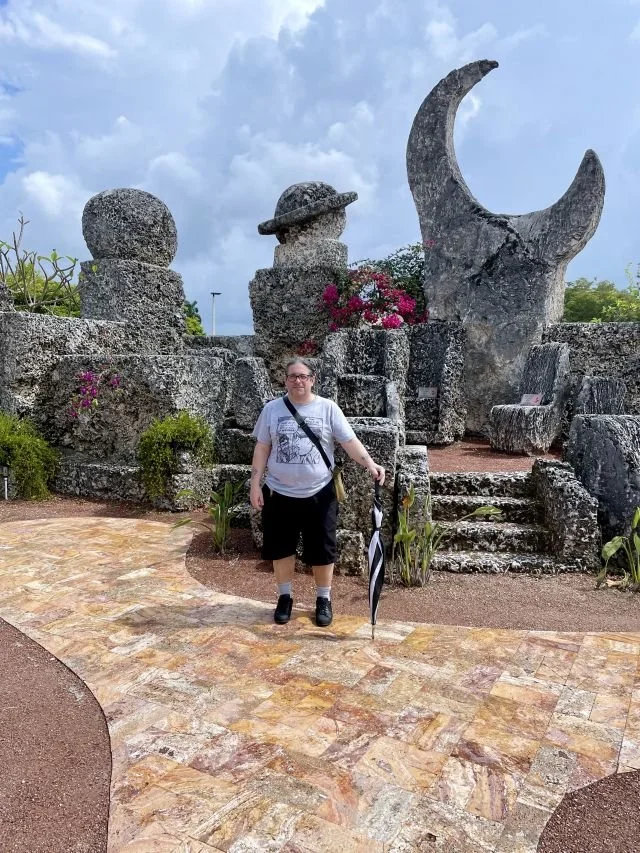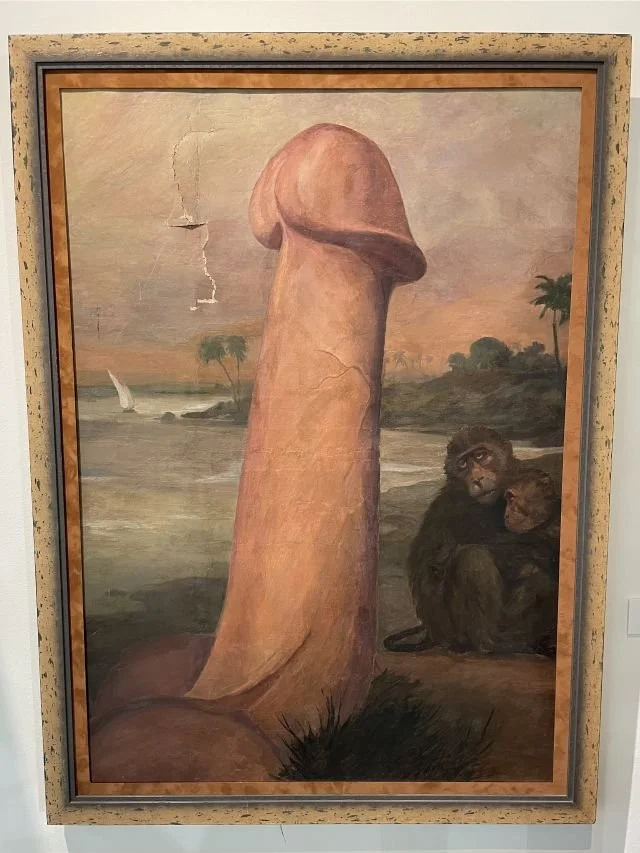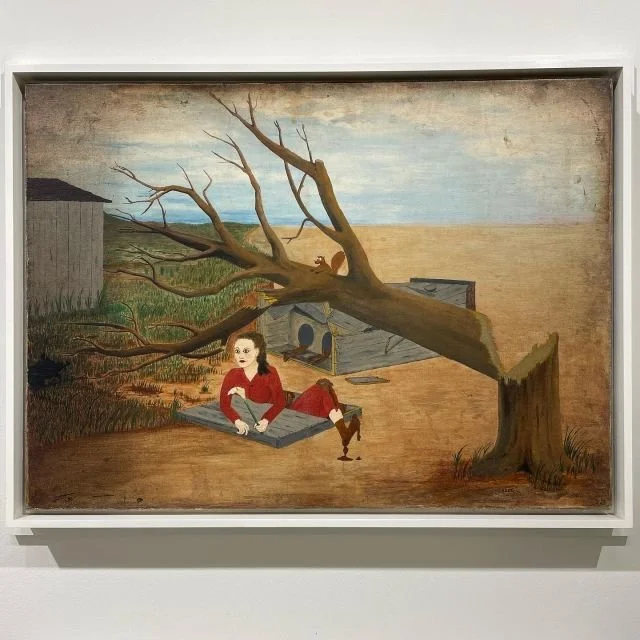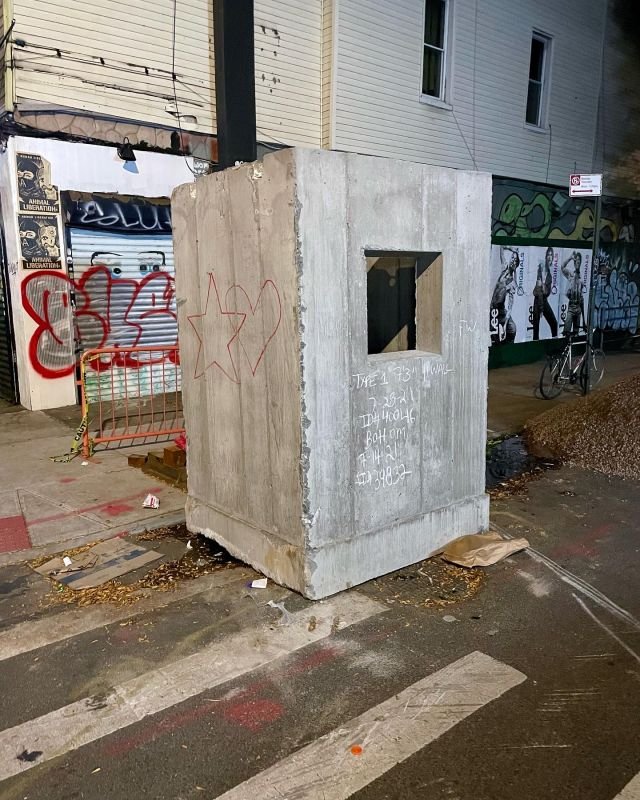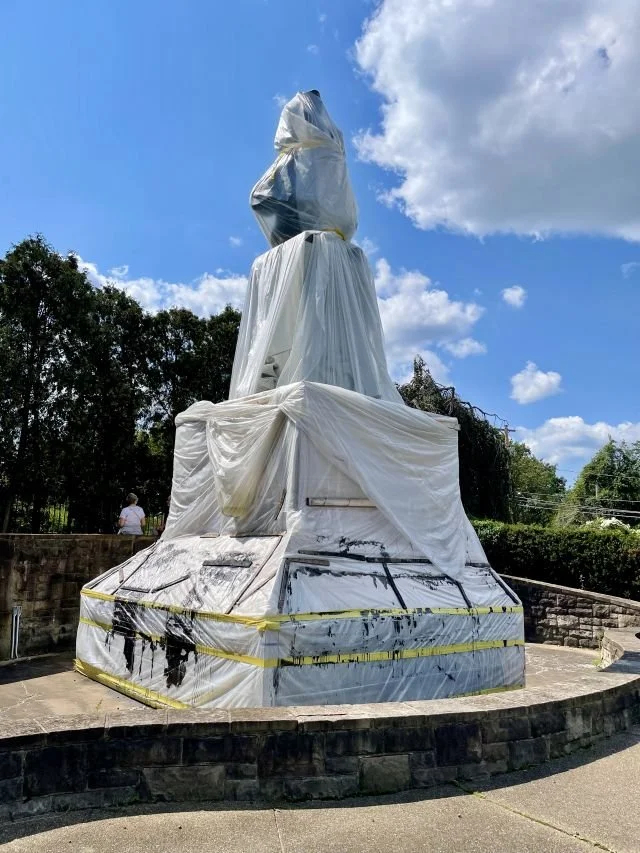Since my last report in July, I had some bad encounters at work with a new manager. After I contacted the regional management to complain, I was given a raise and put into an easier role. It’s strange how more money can amount to a less stressful position. Because of this drama, I decided to shave my head, but first I took a vacation, going back to Georgia just in time for the Atlanta Surrealist Group’s Undertakers and Underselves: A Surrealist Excavation. The event was split into four days and held at the No Tomorrow Gallery in Atlanta’s Underground. The walls were full of collages and paintings from surrealists across the globe. Some of my favorite works were the paintings by Tori Lion, a mask made from yak skin, James Robert Foster’s collage paintings, and the suitcases full of strange sculptures, teeth, and various components. There was a lot of work to take in. Many pieces were small and anonymous. There were also a number of modified dolls, including a very haunting red one with elongated limbs. The excessive amount of dolls could be the influence of Doll’s Head Trail on the Atlanta group. I actually went to Doll’s Head Trail on this trip, and while I found it unkept and cluttered, I could see how people find the decay and bricolage inspiring.
The first day of the event was an improv day. There was a lot of freeform experimentation with noise makers, movement, and costumes. It was somewhat intimidating for me, as I’m not much of a performer. I spent most of the time playing with a Monotron someone handed me. There seemed to be a lot of cathartic screaming happening and Butoh-influenced dance. Many of the costumes seemed to touch on the “under selves” theme of the event. The second day was devoted to game-playing, and I was surprised at the number of random passersby that participated. Also present on that night was someone named Alvaro Michael who performed as The Alumified Man, a persona he created that sits at a table and wraps everything presented to him in aluminum foil. The woman who runs the space, I believe her name was Patricia, also participated by handing out “Admit One” tickets, giving the receiver permission to “admit whatever you’d like.” It was a confessional game.
The third night was for musical performances. Steven Cline asked LaDonna Smith to perform with a dancer named Lucifer, and the improv collaboration left me kind of speechless. The two performers really played off each other. Lucifer exhibited a wildness and childlike quality and LaDonna was very receptive to Lucifer’s bodily movements and sounds. At first, it was LaDonna with her fiddle leading the way, but somewhere in the performance, Lucifer took control. The two had never met before, and the spontaneity of it all added to the magic. LaDonna also brought along with her a certain Dr. Khlurr who was using one of Quintron’s drum buddies. It was fascinating to see one of these machines functioning in real life. The final night was for cinematic creations. The main feature was the Japanese cult film Horrors of Malformed Men, but I felt the truly important moment was seeing the short film The Face of Oblivion by Aaron Dylan Kearns. It’s a strange psychosexual transmission, which I may write more about in the future.
After my time in Atlanta, I again traveled to Savannah, where my friend Sofie Buck gave me two new tattoos and showed me a painting she’d been working on. The painting was based on a postcard collage I sent her earlier in the year, and I do believe she improved the piece. I rarely collaborate with people on artistic projects, but I was very pleased with this one.
Returning to New York, I went to both the Méret Oppenheim show at MOMA and the Morris Hirshfield show at the American Folk Art Museum. The Oppenheim show surprised me with the depth and diversity of her work. Of course, her famous surrealist objects were on display, but her work transcends the typical boundaries of art, tossing back and forth between abstract and realistic styles. I enjoyed her Stone Woman painting, where above water a woman is made of stones, while beneath she is flesh. The show was overwhelming and I plan on making a return visit before it closes in March. I enjoyed the Morris Hirshfield show too, but he’s not as complex of an artist as Oppenheim. The show felt very comprehensive of his work, even including his famous Nude at the Window (Hot Night in July), which is often seen in a photo surrounded by Breton, Duchamp, Ernst, and Leonora Carrington. While Hirshfield’s work primarily focuses on the female form, I found his animals to be charming. The man could simply capture the personalities of animals like no other, whether they are zebras, lions, cats, or dogs.
September was Penny Slinger month in New York. A number of her movies were shown at Spectacle Theater, while Pace Gallery was displaying some of her collages. When I went to Spectacle, Slinger was there with a much younger man who I assumed was her lover. We watched Lilford Hall, a late 60s collaboration with Peter Whitehead. The silent film was shot entirely in an old mansion and has a lot of repetitive moments, often showing the same thing happening over and over again, but in different ways. There are a lot of doors that lead to other doors or nothing at all. Two women, often dressed in black Musidora-like suits, could be found kissing and running around the large empty structure as if playing hide and seek. Sometimes the women were caged or behind fenced-off areas like captured animals. Other times they were nude, lying in bathtubs, or white as ghosts looking out old windows. I found the repetitive moments rather dreamlike as they broke with traditional narrative storytelling, and the doubling and mirroring between the two women reminded me of Bergman’s Personaor Lynch’s Mullholand Drive.
On a different day, Spectacle also showed several of Slinger’s short films. Many of these were just exercises but explored some of the same themes as Lilford Hall. I watched a documentary on Slinger called Out of the Shadows and was pleased to learn that Slinger was once supported by surrealists Roland Penrose and Lee Miller. The collages at the Pace Gallery were taken from Slinger’s book 50% The Visible Woman. There was a newer piece by her at the Pace Gallery, or rather it was a digital monitor that showed some of her newer self-portraits morphing into one another. She showed herself lying naked in a bathtub which then morphed into a sea, and so on. The bathtub is a big feature in her work, as it appears in many of her shorts and in Lilford Hall. What is the symbolism of the bathtub? It’s a private space where you cleanse yourself, but it’s also where you can die, slit your wrists, get electrocuted by a toaster, or just plain drown.
I went to the Whitney Biannual over the summer but found it rather unremarkable. In addition to that, I went to two other art fairs: the famed Armory Show and the DIY underground Spring/Break Show. My favorite piece at the Armory Show was Kapwani Kiwanga’s Ground which linked a series of photos of lightning to create one long stream of lightning. I also enjoyed Woody Vasulka’s video work, where a distorted electrical signal is somehow projected onto a television, then printed to create a “work of art.” The next day I went to the Spring/Break Show, where the art was hit or miss. One of my favorites from this show included Horacio Quiroz’s cubical figures that look like they are made from stone or a halal cone. Jessica Lee’s Lady of the Lake was also a favorite as was Alexandra Evan’s painting of a mermaid surrounded by trash. I noticed that two popular techniques utilized at the Spring/Break Show were mimicry, where one thing acts as another, and multiplicity, which can be seen in the self-portraits of Maya Mason.
Another art event I went to was the show at O’Flaherty’s called The Patriot. I went with surrealists Wayne Kral and Andrew Mendez. While we didn’t go on opening night, apparently there were so many people at the event the police came and shut it down. Originally, the show was supposed to be viewed with flashlights in the dark, but we went after all the hubbub and saw the show with the overhead lights on. Although I am doubtful, I was told nothing was rejected for this show. The whole thing felt very anonymous. Regardless, many of the works had a level of skill about them. There was a painting of a black cat hissing that was my favorite. Wayne pointed out a suitcase with some toilet paper embedded in its casing. There was a painting of two lions eating a zebra, and below it was a weird mongrel dog surrounded by human body parts. There were many mutilated dolls and in the bathroom I found another favorite: a bird with a human hand for a head.
On the music front, in July I went to both the Punk Island festival and Summer Scum 7. Punk Island was free and held in Maria Hernandez Park, a short walk from my apartment. Many bands, mostly local, were selected to play at the festival, but, honestly, not many of them were for me. A band that stood out was The Dilators, a rowdy in-your-face trans-punk band. Summer Scum 7 was a noise festival held this year at TV Eye. I’m never sure how to write about noise artists because I’m not sure I understand the genre, but I do like watching them. One performance I enjoyed was Form Hunter, where some dudes had a metal box and used all these objects to create sound from it. Then a guy named Gnawed performed and had an interesting video being played behind him. The video was in reverse and showed some chains wrapping themselves around a piece of wood, like a couple of snakes or tentacles. It was filmed in a small tunnel and had a cavernous feel to it. My favorite performance at Summer Scum 7 was Rectrix, a solo project of Pippi Zornoza, a Providence-based artist. She used two mics with lights on them and one she would swing, so it would only momentarily capture her voice. The event was intense and half the time I wasn’t sure who I was watching because everything was happening so fast and there were many performers.
As with every city I live in, I find my favorite bands to follow. In New York, it’s been the projects of two sisters. I started following Melissa several years ago after catching them at the Market Hotel. I believe I’ve written about them before. This summer I saw them play two amazing outdoor shows and one really fun, cramped set at Bootleg Bar. Unbeknownst to me until this summer, Melissa’s singer is the sister of Pharmakon’s only member, who I also saw play multiple times this summer. Pharmakon played their first show in three years at the Knockdown Center with Aaron Dilloway of Wolf Eyes, who had a zombie-like set. I first saw Pharmakon many years ago at my house in San Francisco, Bay Area 51, and have been hooked ever since.
At the end of October, I saw a jaw-dropping performance by Narcissister. She was performing at a sort of cabaret event in Brooklyn. For her piece, she came to the stage in what I would call a traditional 1950s mother’s outfit. At first, she was mopping the floor, but when she tried to cook some eggs the carton was empty. Then, Narcissister squatted over the mop bucket and pushed out an egg from her vagina. She did this twelve times, fried the eggs on stage in a frying pan, and handed them out to the crowd. She gave one to me and I ate it. It was humorous, disgusting, revolting, sexy, and giving. I think most people were turned off by the eating of the egg that had been in her pussy, but I found it rather exciting and charitable.
Movies I’ve been watching:
Pearl (Ti West, 2022)
Fire of Love (Sara Dosa, 2022)
Satantango (Béla Tarr, 1994)
Fascination (Jean Rollin, 1979)
What I’ve been reading:
Genesis P-Orridge - Nonbinary: A Memoir
Penny Slinger - 50% The Visible Woman
Jacqueline Burckhardt and Bice Curiger, eds. - Meret Oppenheim: Beyond the Teacup
Matthew Ragsdale - Cinema Schism #1
Music I’ve been listening to on the subway:
Babes in Toyland - Fontanelle
Black Sabbath - Paranoid
Thee Oh Sees - A Foul Form
Killdozer - Burl
